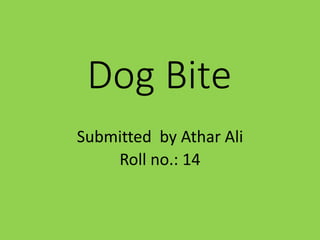
Dog Bite Pathogenesis and Treatment
- 1. Dog Bite Submitted by Athar Ali Roll no.: 14
- 3. Rabies virus enters peripheral nerves, or may replicate in myocytes and spread to motor nerve endings(A) Retrograde intra-axonal (centripetal) spread to the CNS occurs in peripheral motor nerves (B) Virus replicates in spinal cord neurons and spreads rapidly throughout the nervous system, causing progressive lower motor neuron paralysis(C) Virus enters the brain, causing cranial nerve deficits and behavioural changes PATHOGENESIS: (Art by Kip Carter © 2004 University of Georgia Research Foundation Inc.)
- 4. The classical course of canine rabies is divided into three phases: I. Prodromal phase II. Excitative (furious) phase III. Paralytic phase (dumb rabies) Prodromal phase: • Behavioural changes may occur. • Aggressive and highly strung dogs may become friendlier than usual and ordinarily friendly dogs may become shy and seek secluded areas or become snappy and irritable. • The temperature may rise slightly, the pupils may dilate and the nictitating membrane may cover the eye. • Excessive salivation may occur. Clinical Signs
- 5. Excitative (furious) form: (may last for 1 to 7 days) • Animals are restless and irritable and have increased responses to auditory and visual stimuli. • Become excitable, hyperesthetic and bark or bite imaginary objects. • Roam aimlessly, becoming more irritable & vicious. • They may attack others dogs, animals and man; or attacked by other dogs and transmit the virus. • Dogs may eat unusual objects (Pica) especially wood/mud. • The caged dogs often try to bite or attack their enclosure • Excessive Salivation and Foaming particularly at the angle of mouth • Noise may invite attack. Such animals lose caution and fear of people and other animals
- 6. •Sexual excitement in male, Estrus in female may also be present. Later stage (about 5 days) of Furious Rabies: • Animal avoid human contact and hide in dark/ quiet places. • Incoordination, swaying back & disorientation may be noted. • Change of voice because of pharyngeal paralysis. • Occasionally affected animal may develop seizures. • Finally, the animal may suffer a short paralytic stage and then dies.
- 7. The Paralytic or Dumb Rabies (1-10 days) Affected animals will develop; • Incoordination, ataxia, abnormal gait and posture, • Can’t walk in straight line (sway back syndromes) • Hanging jaw and salivation • Unable to eat or drink • Squinting and dilatation of pupils (giving strange look) • Abnormal voice (Hoarse sound like jackal in dogs) due to Pharyngeal paralysis • At the later stages, recumbency with torticollis, paraplegia, followed then by coma and death within 4-10 (7) days
- 8. Cattle Furious rabies can be dangerous, attacking and pursuing people and other animals. • Lactation ceases abruptly in dairy cattle. • The usual placid expression is replaced by one of alertness. • The eyes and ears follow sounds and movement. • A common clinical sign is a characteristic abnormal bellowing, which may continue intermittently until shortly before death.
- 9. Horses and Mules oFrequent distress and extreme agitation accompanied by rolling, may be interpreted as evidence of colic. oAs in other species, horses may bite or strike viciously and, because of their size and strength, become unmanageable in a few hours. People have been killed outright by such animals. oThese animals frequently have self-inflicted wounds.
- 10. Diagnosis •Historyof Rabid dog bite (or seeing of Rabid dog around, couple of days to months before). •Presence of Rabies signs/symptoms. •Detection of Rabies Virus or Viral Antigen. • Laboratory: • Immunohistochemistry •Virus amplification . •PCR
- 11. Treatment (Post-exposure Prophylaxis) A. Wound treatment • Thorough & vigorous cleaning/washing of wound with soap and warm water for at least 5 minute. • Apply Alcohol (40-70%), Methylated Spirit, Ethanol, Tincture of iodine, Povidone-iodine or Quaternary Ammonium Comp. Punctured wound can be washed and cleaned, using blunt end needle and syringe (pressure cleaning), and • Infiltration around the wound of Immunoglobulins (Human source - in particular).
- 12. Treatment (Post exposure prophylaxis) B. Parenteral use of Hyper-immune Anti-rabies Serum (Passive Immunization) C. Post-exposure anti-Rabies vaccination (Active Immunization). NB: Early the treatment - more chances are of evading the disease. More is the delay in treatment - more chances are of getting the disease.
- 13. For clients whose animal has up-to-date rabies vaccinations •Should be revaccinated immediately, • Kept under the owner’s control, and observed for 45 days. •If the animal under observation develops any signs of illness, it should be euthanized. For clients with animals OVERDUE for booster rabies vaccinations • Same as above.
- 14. For a client’s animal that has NEVER been vaccinated against rabies •Should be euthanized immediately •There are no USDA-licensed biologics for postexposure prophylaxis in previously unvaccinated domestic animal. • If the owner is unwilling to have the animal euthanized, the animal should be placed in strict quarantine for 4 (dogs and cats) or 6 (ferrets) months and ( livestock) 6 month.